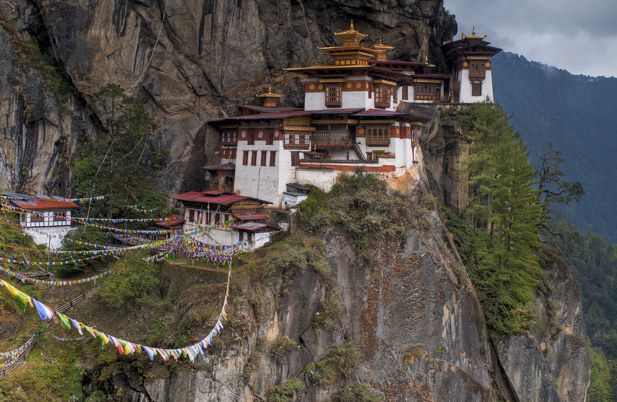Into Sacred Air
Travel Stories: In an excerpt from "Radio Shangri-La," Lisa Napoli makes the climb to Bhutan's Taktsang Monastery
04.10.12 | 11:17 AM ET
The approach to the most sacred monastery in the Kingdom of Bhutan is steep and winding and, especially as you near the top, treacherous. You are sure with one false step you’ll plummet off the edge. Had I been here during certain times over the last few years, I might have hoped I would. It is a cold winter’s Saturday, dark and overcast. Misty gray clouds, pregnant with snow, hug the mountains.
My companions are several of the 20-somethings who staff the new radio station in Bhutan’s capital city, where I’ve come to volunteer. Kuzoo FM 90: The voice of the youth. Pema is wearing jeans and a sweatshirt and flat white dress shoes, the kind you might put on with a demure frock for a tea party. Ngawang’s wearing the same stuff on top, but she’s got sneakers on her feet. Each woman carries a satchel stuffed with her kira, the official national dress, requisite attire for Bhutanese who reach the summit. Kesang is already wearing his gho, the male equivalent. Over it, he’s carrying a backpack filled with 10 pounds of oil to fuel dozens of butter lamps, offerings to be left for the gods. Me, I’m 20 years older, and practicality reigns: I’ve got on my thick-soled boots, an ugly long black down coat with a hood, and six layers of clothing underneath.
So much for the strength I’ve gained from my daily swimming regime; I am huffing and puffing against the altitude and the intensity of the climb. My new friends modulate their sprints to let me keep up.
Bhutanese are hearty in many matters—they are used to living off the land, the hard lives of farmers—but they are particularly strong when it involves making the trek to this place called Taktsang, built on a sheer cliff that soars 10,000 feet into the sky. The depth of their devotion becomes abundantly clear when, out of nowhere, a radiant 12-year-old boy scurries down past us, stark naked, completely unaffected by the temperature and the incline. He’s trailed by a solemn entourage of grown men. Not one of them misses a step. Later, we learn this beatific adolescent is a reincarnated lama on pilgrimage from the remote eastern reaches of this tiny country.
 A pilgrimage to Taktsang is the highlight of a trip to Bhutan, but it is commonplace for the Bhutanese. They are carried here from babyhood. Slight, frail seniors navigate the twists and turns and inclines deftly from memory, in a fraction of the time it takes foreigners half their age. Tales are told of people with physical disabilities who labor for 12 hours so they might reach the top, where a cluster of temples awaits. The most sacred of the altar rooms there is open to the general public only once a year.
A pilgrimage to Taktsang is the highlight of a trip to Bhutan, but it is commonplace for the Bhutanese. They are carried here from babyhood. Slight, frail seniors navigate the twists and turns and inclines deftly from memory, in a fraction of the time it takes foreigners half their age. Tales are told of people with physical disabilities who labor for 12 hours so they might reach the top, where a cluster of temples awaits. The most sacred of the altar rooms there is open to the general public only once a year.
It is believed that meditating for just one minute at Taktsang will bring you exponentially greater blessings than meditating for months at any other sacred site. If you travel here on a day the calendars deem to be auspicious, the merit you accumulate will be even more abundant. Ngawang tells us that the first time she remembers visiting was two decades ago, when she was 4 years old; her mother had died and the monks sent her here to pray.
What Taktsang promises all who visit is cleansing and renewal. Into this valley in the eighth century a sage named Guru Rinpoche rode in on the back of a tigress. Then he retreated to a cave for three months and, with the most powerful weapon there is—his mind—swashbuckled away evil spirits. In so doing, he persuaded the Bhutanese to adopt Buddhism as their guiding light. Hundreds of years later, to mark the feat, a colony of structures was built in this precarious location—testament to how the people of Bhutan have long revered him, this being they consider the Second Buddha.
As we climb higher and higher, and as the gold-topped Taktsang comes into view, I can feel Guru Rinpoche’s strength bolstering my own, diminishing demons, softening my heart.
This is the story of my midlife crisis—and how I wrestled with and then transcended it, thanks to a chance encounter that led me to a mysterious kingdom in Asia few have visited.![]()
Reprinted from the book Radio Shangri-La: What I Discovered on my Accidental Journey to the Happiest Kingdom on Earth by Lisa Napoli. Copyright (c) 2012 by Lisa Napoli. Published by Broadway Paperbacks, a division of Random House, Inc.
Related: Interview with Lisa Napoli: ‘Radio Shangri-La’ in Bhutan
 Taktsang Monastery, Bhutan. Photo by
Taktsang Monastery, Bhutan. Photo by